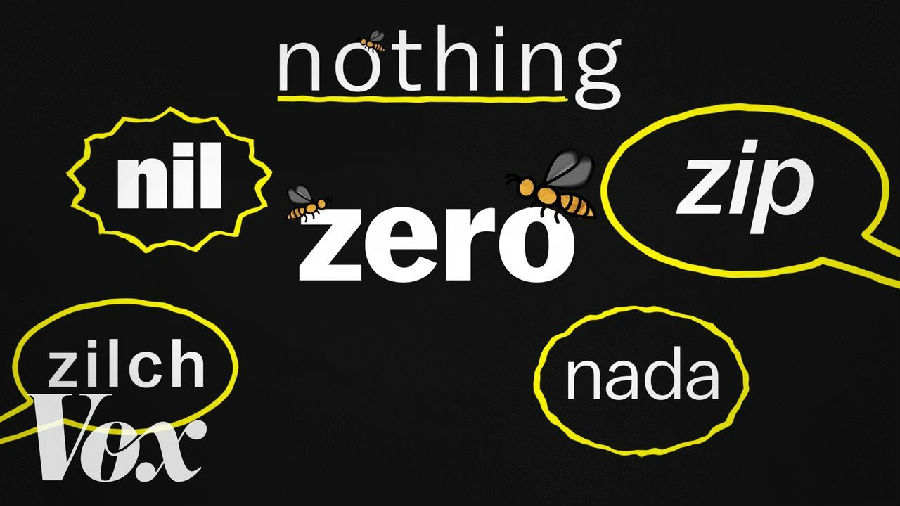Zip, zilch, nil, nada, nothing. We have a lot of words to describe zero.
零有各种各样的说法,Zip,zilch,nil,nada,nothing等等等等。
A number without which we wouldn’t have the likes of James Bond or the code that makes this video play on YouTube.
没有这个数字,我们就没有詹姆斯·邦德,也就没有让这期视频得以在YouTube上播放的代码。
It’s a number that came into existence only 1,500 years ago, a blip in the evolution of humans.
而零这个数字是1500年前才出现的,其历史跟整个人类进化史比起来简直就是弹指一挥间。
Yet, it’s considered one of the most important discoveries in our history …Two. One. Zero. Lift off. We have a lifeoff.
尽管如此,零还是被认为是人类历史上最重要的发现之一……二,一,零。发射。发射了。
But if you ask a kid under the age of 6.
但如果你问一个6岁以下的孩子零是什么。
“Arthur, do you know what zero means?” “Uh…” “A number?” “It’s none.”
“亚瑟,你知道零是什么吗?”“呃......”“一个数字?”“就是没有呗。”
They might be able to tell you that zero is nothing,
他们或许也能够告诉你零就是没有,
but they don’t understand that it is a quantity like other number, a concept that even a tiny bumblebee can learn.
但他们并不直到零和其他数字一样也是数字,而这个概念小小的大黄蜂都知道。
So what's so difficult to grasp about zero?
那么问题来了,零这个数字到底难在哪里呢?
“There’s nothing there.”
“就是里面什么都没有。”
One. two. three. four. five. Six. Seven. Children understand the natural counting numbers long before they understand the number zero.
一。二。三。四。五。六。七。孩子们在学会数数之后很久才能理解零这个数字。
"Can you show me how to get to zero if you have one cookie?"
“你能给妈妈演示一下一块饼干怎样才能变成零吗?”
“Now how many cookies do you have?”
“那你现在还有几块饼干呢?”
I think the other numbers have a sensory equivalent.
其他数字都有可感知的等价物的。
One is one object, one element. Two is two elements-however they look like-but there is something to be counted.
一就是一个东西,二就是两个——不管它们长得像不像——只要算数就行。
And with zero that's just not the case.
零就不是这么回事了。
It's not intuitively understandable that zero can be a number.
零根本就不符合自然认知的规律。
Andreas Nieder believes that humans must comprehend four distinct stages of zero to fully understand the number .
安德烈亚斯·尼德认为,人类得经历四个不同的理解阶段才能完全理解零这个数字。
The first stage is simple: the ability to notice a stimulus or the lack of one.
第一阶段很简单:注意到有刺激和没有刺激的能力。
When you turn on a light bulb, for example,
比如你打开灯泡的时候,
your eyes recognize the presence of that light and send visual information to the brain.
眼睛识别出灯光的存在后,就会将视觉信息传送到大脑。
Without light, the neurons don’t do anything.
没有光的话,神经元就不会工作。
So in the second stage, our brain has to learn how to react to nothing.
接下来是第二个阶段,我们的大脑要学会如何对零做出反应。
The third stage is tougher: understanding that zero is less than one.
第三阶段更难:理解零小于一这个概念。
And it’s this stage that kids struggle with.
孩子们犯难的就是这第三个阶段。
Because even when a toddler can understand that zero represents something, like the absence of a cookie,
因为即使幼儿能够理解零代表了一定的意义,比如没有饼干,
they still don’t understand that it represents an actual quantity.
他们还是不明白它代表的是实际数量。
In an experiment with four year olds, researchers asked the toddlers to pick cards with the fewest dots,
在一项针对四岁儿童的实验中,研究人员要求幼儿选择点数最少的卡片,
and when they compared a blank card and a card with one dot, less than half of the kids got the answer right.
当他们在一张空白卡片和一张只有一个点的卡片中间徘徊时,能够选对的孩子不到一半。
Without understanding this concept, Nieder says humans can’t use zero as a number, the fourth and final stage.
尼德说,不能理解这个概念,就无法在第四个阶段和第五个阶段正确地使用这一数字。
"If you had one cookie and you took it away how many do you have?"
”如果你有一块饼干,你把它拿走了,那你现在还有几块呢?
Two! Two?
两块。两块?

But how the brain gets to that point is still unknown.
但大脑是如何会做出这种反应的我们目前尚不清楚。
In terms of brian research, we hardly know anything. We are just scratching the surface.
就拿大脑研究来说,对此我们还几乎是一无所知。我们还处在隔靴挠痒的阶段。
So while our own brains may still be a mystery, researchers are finding answers in some seriously less complex ones.
尽管我们自己的大脑可能仍然还是一个谜,研究人员还是在一些大脑结构不那么复杂的生物身上找到了答案。
The brain of a bee has 100,000 times fewer neurons than the brain of a human,
蜜蜂大脑里的神经元只相当于人类大脑神经元的10万分之一,
yet scientists in Australia were able to teach them that zero is a quantity less than one.
但澳大利亚的科学家们还是成功地教会了蜜蜂零这个数字比一要小的概念。
“One of the things we wanted to test for was this concept of zero that we see in these seemingly more advanced animals like primates and parrots.
“我们想测试的一个问题就是灵长类动物或者鹦鹉这些高级动物对零这个概念的理解。
And so we did and we got a really interesting answer.”
我们就做了,测试的结果也非常有趣。”
In a study similar to the one done with the young kids, researchers presented bees with cards showing different numbers of dots.
在一项与上文中提到的幼儿研究类似的研究中,研究人员向蜜蜂展示了点数不同的卡片。
And the bees were rewarded with sugar water when they selected the card with the smallest amount.
当蜜蜂选择了点数最少的卡片时,就能够得到糖水作为奖励。
After the bee correctly chose the smaller number 80 percent of the time, the researchers upped the challenge.
蜜蜂的正确率达到80%以后,研究人员加大了挑战难度。
They added blank cards to the test.
他们在测试中增加了空白卡。
“So the important thing from this first experiment show us that bees that were trained to always choose the lower number in training,
“我们从第一次实验中得出了一个重要的信息,那些接受过训练,需要反复选出点数最少的卡片的蜜蜂,
regardless of not having seen an empty set before and never having been rewarded for it, chose the empty set.”
无论之前有没有看过空白卡片,也不管之前有没有拿到过奖励,在第二轮实验中都选择了空白卡片。“
Bees also showed that they understood zero as a quantity on the number line,
实验还表明,蜜蜂们明白零在数字序列中的位置,
because they more accurately chose the empty set when comparing it to a larger number like five or six than when they compared it to just one.
因为在和五或者六这种比较大的数字相比时,它们选对空白卡片的准确率要比跟一相比时高。
“They're more accurate with numbers that are further apart, which is called ‘numerical distance effects.’”
“他们对距离更远的数字的判断更准确,这种现象被称之为'数值距离效应'。”
And it's something that's defined as being very important to show that an animal or even a human has an understanding of number quantity.
这一数字也被认为非常重要,因为它表明动物,甚至是人对数量是有一个认识的。
The findings of this study suggest the ability to understand zero may be more widespread in the animal kingdom than previously thought.
这项研究的结果表明,动物王国理解零的能力可能比我们以前想象的更为普遍。
And, it’s possible that in deconstructing how the bees compute numbers, we could make better, more efficient computers one day.
并且,或许通过解密蜜蜂是如何数数的,有朝一日我们就能制造出更好、更高效的计算机。
Plus, studying the brains of bees and other animals
此外,研究蜜蜂和其他动物的大脑
can help scientists better learn how humans understand zero,
也可以帮助科学家更好地了解人类是如何理解零这个数字的,
enough to do our algebra homework — or just look for more cookies.
那时我们再做几何作业就容易了 - 哪怕只是为了找到更多的饼干也好啊。
“What is nothing?” "Crumbs! Crumbs on a plate"
“零是什么呢?”“渣渣!就是盘子里的渣渣”
Who knew that nothing could this complicated?
谁知道零还能这么复杂?
Hi, if you want to learn more about how bees are impacting the food that you eat,
大家好,想知道蜜蜂对大家食用的食品的影响吗?
make sure to check out this video from our sister channel Verge Science.
那就记得去看我们姐妹频道Verge Science的视频噢。
And thanks for watching.
感谢大家的收看。











